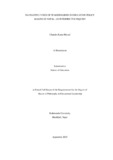
Please use this identifier to cite or link to this item:
https://hdl.handle.net/20.500.14301/545| Title: | Navigating Voice of Stakeholders in Education Policy Making in Nepal: An Interpretive Inquiry |
| Authors: | Bhusal, Chandra Kanta |
| Issue Date: | Sep-2025 |
| Publisher: | Kathmandu University School of Education |
| School: | SOED |
| Department: | DOEL |
| Level: | M.Phil. |
| Program: | MPhil in Educational Leadership |
| Abstract: | The study was conducted with the main purpose of exploring the perceptions and reflections of key stakeholders on their engagement in the education policy-making process of Nepal, with a particular focus on the School Education Sector Plan (SESP) making. I purposively selected seven participants and gathered their perceptions, stories, and experiences through in-depth interviews. Adopting an interpretive inquiry as my research method within the broader interpretive research paradigm, I analyzed their insights through the conceptual frameworks of three different theories, viz. Voice Theory, Policy-Making Theory, and Social Systems Theory. By exploring how participants perceived and reflected on their roles and the representation of their voices in the SESP making process, I saw a disconnect between the claims made in official policy documents, i.e., SESP and the realities experienced by stakeholders on the ground (MoEST, 2022d). Although such documents highlight meaningful stakeholder engagement in education policy processes, the participants revealed a different reality. While certain influential actors, like government officials and central leaders of the Confederation of Nepali Teachers (CNT), had substantial access and influence, other groups, including parents, community representatives, and local government representatives like NARMIN, were either marginally engaged or completely excluded from the SESP process. This dissonance between documented policy intent and actual practice illuminated the contested nature of stakeholder ownership and engagement in Nepal's education policy landscape. Furthermore, I came to understand that entrenched power structures, hierarchical decision-making, and inadequate mechanisms for communication and feedback significantly limited authentic stakeholder engagement. Even those who had formal opportunities in policy decision-making often felt that their substantive contributions were not taken into account during the finalization of policies and plans, as they informed their critical inputs were often overlooked during final decision making. These insights reinforced theoretical perspectives suggesting that structural constraints and institutional hierarchies influence whose voices are sincerely heard in the policy-making arena. Participants also indicated that mechanisms such as consultations and committee memberships tended to be more symbolic than impactful, challenging the nature of inclusion as portrayed in official policy documents. This study concluded that creating inclusive and actionable education policies like the SESP requires more than procedural engagement. It calls for the establishment of enduring, well-structured, and systemic strategies that actively involve diverse voices throughout the policy process, engaging the stakeholders to whom the policies are meant. The interpretive inquiry underscored the importance of re-evaluating current models of stakeholder engagement and fostering mechanisms such as feedback loops, capacity development, and inclusive dialogue forums. Through this research, I came to see the critical need for a transformative shift in Nepal’s education policy-making approach, one that is rooted in meaningful stakeholder engagement and informed by both theoretical insight and lived experience. |
| URI: | https://hdl.handle.net/20.500.14301/545 |
| Appears in Collections: | Dissertation |
Files in This Item:
| File | Description | Size | Format | |
|---|---|---|---|---|
| Chandra Kanta Bhusal Dissertation (Final for Printing and Binding in 10.18 ).pdf | 1.71 MB | Adobe PDF |  View/Open |
Items in DSpace are protected by copyright, with all rights reserved, unless otherwise indicated.